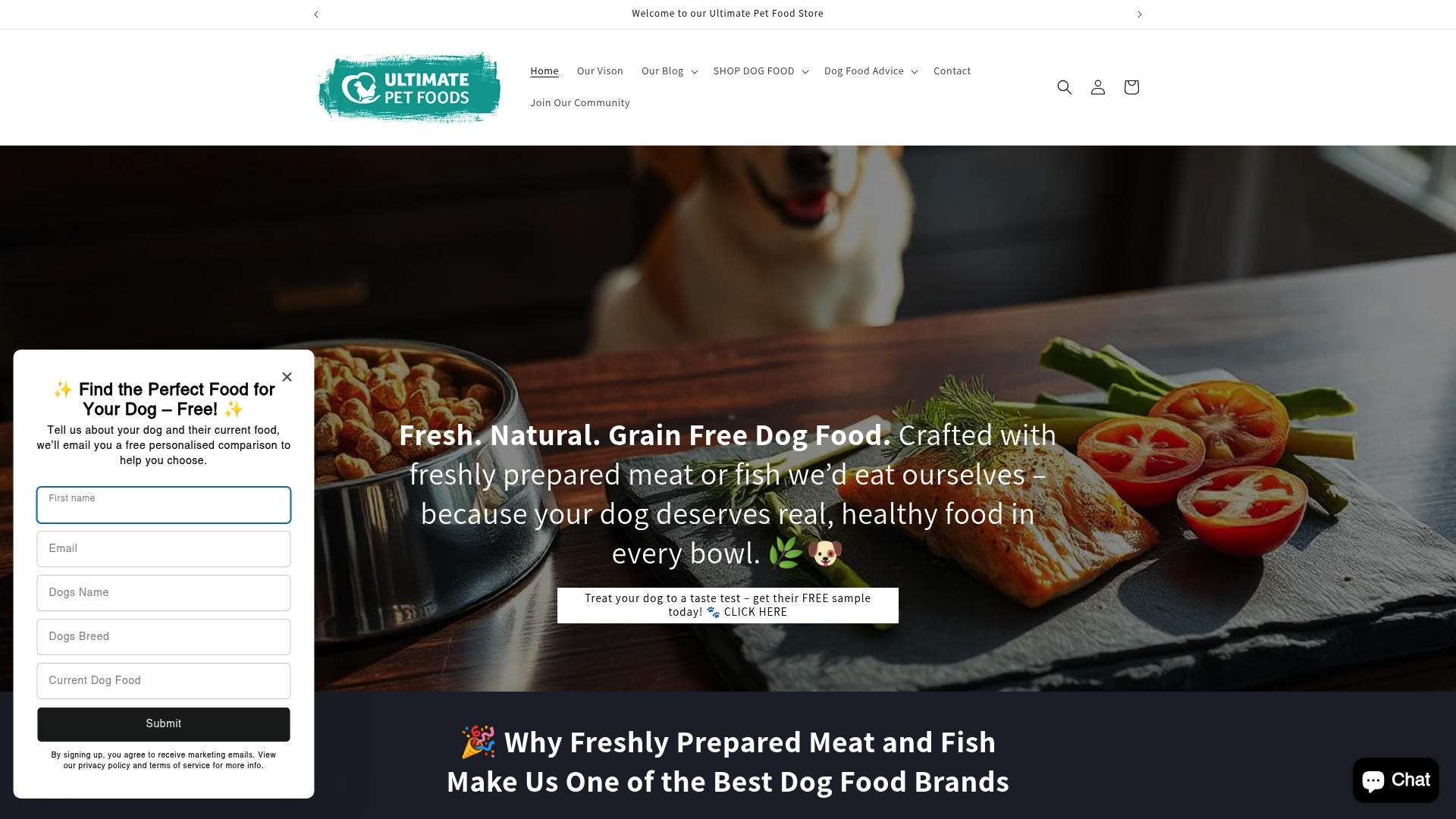
Homemade Dog Treat Recipes: Easy, Healthy, and Natural Ideas
Share
Over seventy percent of dog owners say they feel more connected with their pets when making homemade treats together. Choosing to create safe and healthy snacks for your dog at home can give you peace of mind and strengthen your bond. With the right knowledge, you can avoid common ingredient hazards, select natural options that suit your dog’s needs, and enjoy the process while supporting their well being.
Table of Contents
- Step 1: Start Making Homemade Dog Treats Safely
- Step 2: Choose Natural, Dog-Friendly Ingredients
- Step 3: Prepare Simple Healthy Dog Treat Recipes
- Step 4: Avoid Common Ingredient Hazards for Dogs
- Step 5: Enhance Treat Time with Functional Dog Treats
- Step 6: Shop Ultimate Functional Treats Online
Quick Summary
| Key Point | Explanation |
|---|---|
| 1. Avoid toxic ingredients for dogs | Steer clear of hazardous foods like chocolate, xylitol, and certain nuts to ensure your dog’s safety. |
| 2. Use natural, healthy ingredients | Incorporate wholesome ingredients like lean proteins, fruits, and vegetables to support your dog’s nutrition. |
| 3. Gradually introduce new ingredients | Monitor your dog’s reaction to new foods by adding them slowly and in small amounts. |
| 4. Select functional ingredients for health | Enhance treats with ingredients like turmeric and ginger that provide additional health benefits. |
| 5. Consult your veterinarian for guidance | Always check with your vet about your dog’s specific dietary needs and any potential allergies. |
Step 1: Start Making Homemade Dog Treats Safely
Welcome to the wonderful world of crafting delicious and nutritious homemade dog treats. Making treats for your furry friend is not just a fun activity but also an opportunity to provide wholesome nutrition tailored specifically to their needs.
Before diving into treat preparation, it is crucial to understand ingredient safety. According to Battersea Dogs Home, certain ingredients can be toxic to dogs and must be strictly avoided. This includes substances like xylitol, chocolate, macadamia nuts, and some artificial sweeteners.
When selecting ingredients, focus on natural whole foods that offer nutritional benefits. Consider using ingredients such as:
- Lean proteins like boiled chicken or turkey
- Pureed pumpkin
- Sweet potato
- Oats
- Plain yogurt
- Eggs
Pro Tip: Always introduce new ingredients gradually and in small quantities to monitor your dog’s individual digestive response.
Before preparing any homemade treats, consult with your veterinarian about your dog’s specific dietary requirements and potential allergies. This step ensures you are creating treats that are not just tasty but also supportive of your dog’s overall health.
With these foundational guidelines, you are now ready to explore some delightful easy dog treat recipes for healthy snacks that will have your pup wagging with excitement.
Step 2: Choose Natural, Dog-Friendly Ingredients
Now that you understand the basics of safe treat making, let us explore selecting the most nutritious and delectable ingredients for your furry companion. The key to creating outstanding homemade dog treats lies in choosing high-quality natural components that support your dog’s health and taste buds.
According to The Dog Chef, some fantastic natural ingredients can transform your treats from basic snacks to nutritional powerhouses. Consider incorporating foods like:
- Fruits: Apples and bananas (seedless and peeled)
- Vegetables: Beetroot and sweet potato
- Healthy fats: Coconut oil
- Herbal boosters: Alfalfa, mint, and nettle leaf
Research from Better Natural Treats emphasises the importance of selecting high-quality proteins as the foundation of your treats. Look for lean protein sources such as:
- Boiled chicken
- Lean beef
- Fresh fish
Pro Tip: Always introduce new ingredients gradually and watch for any allergic reactions.
For deeper insights into natural ingredient selection, check out our comprehensive guide on understanding natural dog food ingredients that can help you make informed nutritional choices for your pup.
Remember that variety is key. By rotating different natural ingredients, you provide a range of nutrients while keeping treat time exciting and nutritionally balanced.

Step 3: Prepare Simple Healthy Dog Treat Recipes
With your ingredients selected, it is time to transform them into delicious and nutritious treats that will make your furry friend’s tail wag with excitement. Creating homemade dog treats is simpler than you might imagine and offers a wonderful opportunity to control exactly what goes into your pup’s snacks.
According to Nisa Locally, you can craft healthy treats using straightforward ingredients that are both tasty and nutritious. Here is a simple recipe to get you started:
Ingredients:
- Grated carrot
- Butternut squash
- Wheat-free flour
- Eggs
- Unsweetened peanut butter
For those seeking grain-free options, Broad Reach Nature recommends an alternative approach using:
- Rolled oats
- Eggs
- Pure pumpkin purée
- Unsweetened apple sauce
Pro Tip: Always mix ingredients thoroughly and bake at a low temperature to preserve nutritional value.
If you are looking for more inspiration, our wholesome dog-friendly recipes guide offers additional insights into creating nutritious treats that your pup will love.
Remember that homemade treats are about showing love and care. Each batch is a special gesture that connects you with your beloved companion through nutrition and attention.
Step 4: Avoid Common Ingredient Hazards for Dogs
Creating delicious homemade treats requires more than just good intentions. Equally important is understanding which ingredients could potentially harm your furry companion. Being aware of food hazards is crucial to ensuring your dog remains happy and healthy.
According to Dogs and a Lot More, there are several key ingredients and conditions you must avoid when preparing dog treats:
Ingredients to Steer Clear Of:
- High-sodium foods
- Artificial sweeteners
- Moldy or spoiled ingredients
- Xylitol
- Chocolate
- Grapes and raisins
- Onions and garlic
- Raw yeast dough
Pro Tip: When in doubt about an ingredient, always consult your veterinarian before including it in your dog’s treats.
For comprehensive guidance on navigating potentially dangerous ingredients, our guide on what ingredients to avoid in dog food provides extensive insights to keep your pup safe.
Remember that your goal is to create treats that not only taste good but also contribute positively to your dog’s overall health and well being. Careful ingredient selection is your first line of defence in responsible treat making.
Here’s a helpful comparison of safe and hazardous ingredients to consider when making homemade dog treats:
| Ingredient Type | Safe for Dogs | Avoid for Safety |
|---|---|---|
| Lean Protein | Boiled chicken Lean beef Fresh fish |
Processed meats Raw yeast dough |
| Fruits | Apples (seedless) Bananas Blueberries |
Grapes Raisins |
| Vegetables | Sweet potato Beetroot Butternut squash |
Onions Garlic |
| Fats & Oils | Coconut oil Plain yogurt |
Butter High-sodium foods |
| Others | Oats Eggs Parsley Pumpkin |
Chocolate Xylitol Mouldy foods |
Step 5: Enhance Treat Time with Functional Dog Treats
Treats are more than just rewards for good behaviour. They can be powerful tools for supporting your dog’s overall health and wellness. By strategically incorporating functional ingredients, you can transform simple snacks into nutritional powerhouses that benefit your furry friend.
According to Bone It Up, certain ingredients can provide remarkable health benefits. Research highlights specific functional ingredients that can supercharge your homemade treats:
Functional Ingredients to Consider:
- Parsley for breath freshening and vitamin boost
- Turmeric for its potent anti-inflammatory properties
- Ginger to support digestive health
- Coconut oil for skin and coat wellness
- Blueberries as antioxidant powerhouses
Pro Tip: Introduce new functional ingredients gradually and in small quantities to monitor your dog’s individual response.
For those seeking targeted wellness support, our Digestive Wellness Dog Treat offers a scientifically formulated alternative to homemade options.
Remember that while homemade treats are wonderful, they cannot replace comprehensive nutritional support. Functional ingredients are a fantastic supplement to a balanced diet tailored to your dog’s specific health needs.
Step 6: Shop Ultimate Functional Treats Online
While homemade treats are wonderful, sometimes you need convenient professional options that deliver precise nutritional support. Our functional dog treats range offers scientifically formulated solutions that complement your dog’s dietary needs.
According to The Dog Chef, pet owners should prioritise natural ingredients when selecting treats. Our online collection delivers exactly that with treats containing premium components like:
Natural Ingredient Highlights:
- Apple and banana for natural sweetness
- Beetroot for essential nutrients
- Coconut oil for healthy fats
- High quality protein sources
- No artificial additives
Pro Tip: Look for treats with transparent ingredient lists and specific functional benefits.
For comprehensive wellness support, explore our Dog Treats collection which offers targeted solutions for different health needs. Whether you are seeking dental health support or digestive wellness, we have scientifically crafted options to support your dog’s overall vitality.
Remember that while homemade treats show love, functional treats provide structured nutritional support your furry friend deserves.
Elevate Your Dog’s Nutrition with Premium Natural Treats
Making homemade dog treats allows you to lovingly control every ingredient and avoid harmful additives like xylitol or chocolate. Yet, ensuring every treat supports your dog’s overall health can sometimes feel overwhelming. Whether you seek wholesome recipes or need inspiration to complement your pup’s daily diet, choosing natural, grain-free, and nutritionally balanced options is key for peace of mind.

Discover how Chicken Dog Food : Healthy & Natural | Ultimate Pet Foods offers carefully crafted, premium ingredients that align with your commitment to natural nutrition. Or explore a broader range of tastes with our Salmon Dog Food – Premium, Healthy, Hypoallergenic & Omega-Rich – Ultimate Pet Foods collection to support skin, coat and overall vitality. Don’t settle for ordinary when your dog deserves the best. Visit Ultimate Pet Foods now and elevate treat time into a nourishing experience. For a first step, try our All Our Dog Food Samples – Ultimate Pet Foods to find the perfect match for your furry companion’s needs.
Make your dog’s health your priority and act today for a happier, healthier tomorrow.
Frequently Asked Questions
What are some easy homemade dog treat recipes I can try?
Start with simple recipes that require natural ingredients, such as grated carrot, butternut squash, and eggs. For a no-bake option, mix rolled oats, pure pumpkin purée, and unsweetened apple sauce, then form into treats and let them set in the fridge.
How do I ensure the ingredients I use are safe for my dog?
Avoid harmful ingredients like xylitol, chocolate, and certain fruits such as grapes and raisins. Always check for potential allergens and introduce new ingredients gradually to monitor your dog’s reaction.
What healthy ingredients should I include in homemade dog treats?
Focus on natural whole foods like lean proteins (boiled chicken, lean beef), veggies (sweet potato, beetroot), and healthy fats (coconut oil). Aim for a balanced mix to ensure your dog gets essential nutrients in their treats.
How can I make grain-free dog treats at home?
Combine grain-free ingredients like rolled oats, eggs, and pure pumpkin purée for a simple baking option. Alternatively, use mashed sweet potato as a base with additional safe ingredients, shaping into treats and baking until firm.
Can I add functional ingredients to my homemade dog treats?
Yes, incorporate functional ingredients like parsley for fresh breath or turmeric for its anti-inflammatory properties. Start with small amounts, such as a teaspoon, to see how your dog responds before increasing the quantity in future batches.
How do I store my homemade dog treats for freshness?
Store your treats in an airtight container at room temperature for up to a week, or keep them in the fridge for about two weeks. For longer storage, consider freezing them in batches for up to three months.
